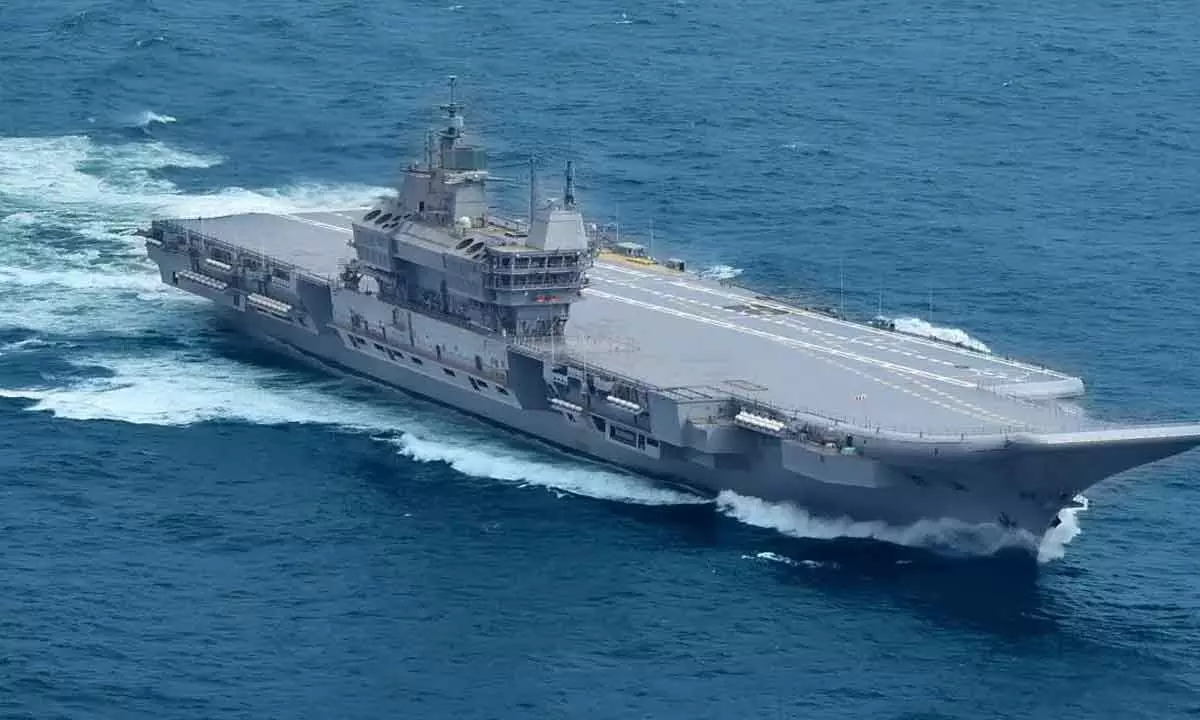Why India needs third aircraft carrier

Navy has long been demanding 3 carriers to ensure at least 2 are operationally available
India's aircraft carrier programme has gone a tectonic shift with the commissioning of its first Indigenous Aircraft Carrier – IAC-I 'Vikrant' on September 2, 2022 as the Indian Navy pushes for a third carrier to retain its combat edge over China in the Indian Ocean Region (IOR). The clamour for the third aircraft carrier is growing louder as India wants to become a Blue Water Superpower. A Blue Water Navy can operate globally in any ocean across the world in deep waters and is a potent force in establishing a country's supremacy.
Nothing compares combat power to an aircraft carrier that protects its accompanying warships and submarines, including other ships, against hostile enemies. On the high seas, where the merchant ships ply, there are constraints for shore-based aircraft by their reach and lack of air bases at sea. In such a scenario, the aircraft carrier can operate continuously and without any constraints, thereby affording protection to own ships. Within the protective 'umbrella' of an aircraft carrier's air defence, other ships like frigates and destroyers can perform their task of offensive strikes and other missions effectively. Therefore, the importance of an aircraft carrier in naval parlance is the pride of any nation. The entry of an aircraft carrier signals a game changer in the blue water supremacy for any country.
The 45,000-tonne indigenous aircraft carrier INS Vikrant will hugely boost India's maritime power and sea control capabilities when she becomes fully combat-ready after undergoing further trials with its complements of 30 fighter jets and helicopters by mid-2023. The Indian Navy has long been demanding three carriers to ensure at least two are operationally available - one each for the eastern and western seaboards, while the third undergoes its maintenance-and-refit cycle. The Navy has been without an operational aircraft carrier for almost two years since INS Vikramaditya is undergoing a significant refit. The timings are crucial when China is fast building two more carriers after it launched its third carrier 'Fujian' in June this year to dominate the blue-water Navy.
Therefore, multiple carrier battle groups will play a crucial role in boosting India's maritime diplomacy and countering threats, especially the hegemonic blue-water ambitions of the Chinese Navy in the Indian Ocean Region.
"INS Vikrant, once fully combat ready, will play a role in ensuring peace and stability in the Indo-Pacific region. Commissioning of the carrier will provide the required deterrence, considering the growing strength of our neighbours and the endurance of our maritime capability," said Navy Vice Chief Vice Admiral Satish N Ghormade.
Echoing the need for a third carrier, former Deputy Chief Vice Admiral M S Pawar argued that "the Indian Navy is very clear about its priorities. Why is China going aggressively with its carrier plans if carriers have lost relevance? They are aiming to make a dozen carriers by the next decade. So, the Indian Navy not only needs a third carrier but should be bigger and better than the existing ones."
Therein lies the pressing need for India to have at least three carriers. To learn lessons from the experience of the making of INS Vikrant -this took almost two decades to become a reality after the government first sanctioned it in January 2003. India should use in the futurethe knowledge and skill set acquired from this project, including the vast ecosystem in place.
Naval vicechief made a solid point to pitch for the subsequent aircraft carrier. "The indigenous ecosystem has been created by building the IAC. The stage is now well set to take the next step forward to indigenously build the next aircraft carrier to ensure the expertise gained is utilisedto the maximum in times to come".
With the confidence that comes from such an exceptional achievement, Madhu S Nair, Chairman and Managing Director, Cochin Shipyard Limited,the makers of the Vikrant, claimed that the shipyard could build another carrier in around eight years with a new dry dock that would be ready by 2023 for building a larger carrier.
China's Aggressive
Thrust in IOR
It is well-known that China, which has been demonstrating an increasingly aggressive posture along the land boundary with India, is also attempting to get a foothold in the Indian Ocean. With the world's largest Navy of 355 warships and submarines, China deploys 7-8 vessels in the IOR anytime. Towards this, it has already acquired a naval outpost in Djibouti and invested in developing the Gwadar port in Pakistan. The Chinese Navy will use these facilities to support its ships.
India and China were recently at odds over the docking of a Chinese spy ship in Sri Lanka's Hambantota port for a seven-day replenishment, which India had vehemently opposed due to security concerns. Sri Lanka initially requested a delay in the ship's arrival over India's objections, but eventually, it got approved following "extensive consultations at a high level." These developments are a cause for concern in the Indian security establishment.
China's contentions in the IOR are to protect its sea lines of communication through the Straits of Malacca and the Hormuz Straits. The Hormuz Straits account for 40 per cent of China's oil imports. The Straits of Malacca also accounts for a major chunk of China's oil imports, popularly known as the 'Hormuz-Malacca Dilemma', and that is the reason why China is attempting to encircle India by building a string of naval bases known as the "String of Pearls" to surround India's neighbours and various neighbouring island States.
The String of Pearls is a network of Chinese military and commercial bases from the Chinese mainland to Port Sudan in the Horn of Africa. This network passes through crucial maritime choke points that include the Strait of Malacca, Strait of Hormuz, Strait of Mandeb, Gwadar Port in Pakistan, and Hambantota Port in Sri Lanka. China has long wanted to control the Indo-Pacific region, which is essential for its security and commercial shipping. The String of Pearls is one such initiative by China in this direction.
With the induction of INS Vikrant and the preparations for India's third aircraft carrier already being set in motion, India is now well poised to contain China's String of Pearls. It is a clear message to China and Pakistan of its nefarious design in keeping with the theme of being a 'Combat ready, credible and cohesive force' in the India Ocean Region.
(Author is a journalist who writes on defence, strategic affairs and technology)















